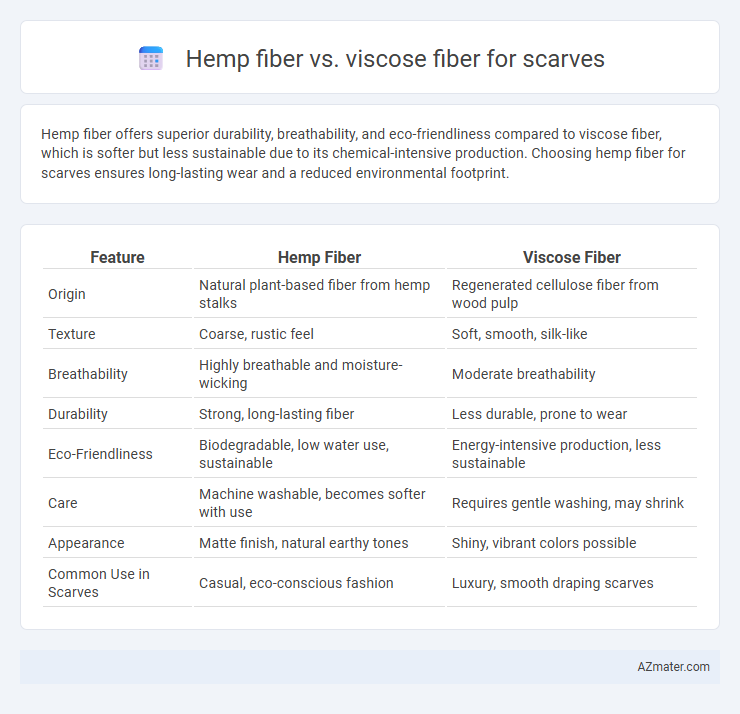Hemp fiber offers superior durability, breathability, and eco-friendliness compared to viscose fiber, which is softer but less sustainable due to its chemical-intensive production. Choosing hemp fiber for scarves ensures long-lasting wear and a reduced environmental footprint.
Table of Comparison
| Feature | Hemp Fiber | Viscose Fiber |
|---|---|---|
| Origin | Natural plant-based fiber from hemp stalks | Regenerated cellulose fiber from wood pulp |
| Texture | Coarse, rustic feel | Soft, smooth, silk-like |
| Breathability | Highly breathable and moisture-wicking | Moderate breathability |
| Durability | Strong, long-lasting fiber | Less durable, prone to wear |
| Eco-Friendliness | Biodegradable, low water use, sustainable | Energy-intensive production, less sustainable |
| Care | Machine washable, becomes softer with use | Requires gentle washing, may shrink |
| Appearance | Matte finish, natural earthy tones | Shiny, vibrant colors possible |
| Common Use in Scarves | Casual, eco-conscious fashion | Luxury, smooth draping scarves |
Introduction to Hemp Fiber and Viscose Fiber
Hemp fiber, derived from the stalks of the Cannabis sativa plant, is renowned for its durability, breathability, and natural resistance to mold and UV rays, making it an eco-friendly choice for scarves. Viscose fiber, a semi-synthetic material produced from regenerated cellulose, offers a silky texture and excellent drape, providing a luxurious feel and vibrant color retention for fashion accessories. Both fibers present distinct advantages in scarf production, with hemp emphasizing sustainability and strength, while viscose focuses on softness and aesthetic appeal.
Origin and Production Process
Hemp fiber is derived from the stalks of the Cannabis sativa plant through a natural retting and decortication process that separates the bast fibers, resulting in a strong, durable textile ideal for scarves. Viscose fiber originates from cellulose extracted from wood pulp, which undergoes chemical treatment and spinning in a viscous solution to create a soft, smooth fabric. The sustainable, eco-friendly cultivation and minimal chemical input in hemp production contrast with the chemically intensive processing required for viscose fiber manufacturing.
Environmental Impact and Sustainability
Hemp fiber is highly sustainable due to its rapid growth, low water usage, and natural resistance to pests, making it an eco-friendly choice for scarves with minimal chemical inputs. Viscose fiber production often relies on intensive chemical processing and non-renewable wood pulp sources, resulting in greater environmental pollution and deforestation concerns. Choosing hemp fiber for scarves significantly reduces carbon footprint and promotes biodegradable, renewable textile alternatives compared to viscose.
Texture and Feel: Comfort on the Skin
Hemp fiber offers a naturally coarse texture that softens with use, providing excellent breathability and durability ideal for eco-conscious scarf wearers. Viscose fiber delivers a smooth, silky feel with a lightweight, draping quality that enhances comfort against sensitive skin. Both fibers bring unique tactile experiences: hemp for rugged, breathable warmth and viscose for soft, luxurious comfort.
Durability and Longevity
Hemp fiber offers superior durability and longevity for scarves due to its natural resistance to wear and tear, maintaining strength after repeated washes and extensive use. Viscose fiber, while soft and smooth, tends to weaken more quickly over time and is prone to pilling and damage from moisture exposure. Choosing hemp fiber ensures a scarf with robust tensile strength and long-lasting performance in daily wear.
Moisture Absorption and Breathability
Hemp fiber exhibits superior moisture absorption and breathability compared to viscose fiber, making it an excellent choice for scarves in warm and humid conditions. Hemp's natural hygroscopic properties allow it to wick moisture away from the skin efficiently, promoting comfort and reducing clamminess. Viscose, although breathable, can retain moisture and may feel damp against the skin, impacting overall comfort during extended wear.
Dyeing Properties and Color Retention
Hemp fiber exhibits excellent dye absorption due to its porous structure, resulting in vibrant, long-lasting colors that resist fading over time, making it ideal for scarves requiring durable color retention. Viscose fiber, derived from cellulose, offers smooth and even dye uptake, producing bright and uniform hues, but it tends to fade faster when exposed to sunlight and frequent washing compared to hemp. The natural resilience and UV resistance of hemp fibers provide superior performance in maintaining scarf color integrity under varied environmental conditions.
Cost Comparison: Hemp vs Viscose Scarves
Hemp fiber scarves generally have a higher initial cost due to sustainable cultivation and eco-friendly processing methods, whereas viscose scarves tend to be more affordable as they are mass-produced from wood pulp. Over time, hemp scarves offer greater durability and longevity, potentially offsetting the initial investment compared to the shorter lifespan of viscose scarves. Buyers seeking eco-conscious and durable options may find hemp scarves more cost-effective despite a higher upfront price.
Style and Versatility in Fashion
Hemp fiber offers a natural, coarse texture that gives scarves an earthy, rustic charm, appealing to eco-conscious and bohemian fashion styles. Viscose fiber provides a smooth, silky finish with excellent drape, making scarves versatile for both casual and elegant outfits while maintaining comfort and breathability. Choosing between hemp and viscose fibers depends on the desired aesthetic and flexibility, with hemp lending durability and rustic style and viscose excelling in softness and style adaptability.
Choosing the Right Fiber for Your Scarf
Hemp fiber offers durability, breathability, and eco-friendly qualities, making it ideal for scarves that require long-lasting wear and natural texture. Viscose fiber provides soft, smooth, and lightweight characteristics, perfect for scarves emphasizing comfort and vibrant draping. Selecting between hemp and viscose depends on desired scarf properties such as sustainability, texture, and maintenance preferences.

Infographic: Hemp fiber vs Viscose fiber for Scarf
 azmater.com
azmater.com